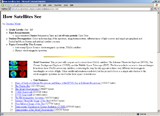How Satellites See
This project will compare and contrast three NASA satellites: The Extreme Ultraviolet Explorer (EUVE), The Cosmic Background Explorer (COBE), and the Hubble Space Telescope (HST). The lesson includes access to data and images from these three NASA astronomy satellites, contrasting the way the sky appears in three very different electromagnetic wavelengths or colors of light. Other satellite information is included, but the project's focus is a simple introduction to the electromagnetic spectrum as used by the three space observatories.
Key Questions
1. What do satellite images really show us?
2. What forms of light do each of the following satellites use (EUVE, COBE, and HST)?
Learning Objectives
1. Students will compare physical parts and orbits of each satellite.
2. Students will compare images about each satellite and will participate in hands-on experiments to begin to understand visible, infrared and ultraviolet wavelengths.
General Subject Areas
Astronomy, Space Science, Satellites, Physics
|
 Author: Chris Wilder
Author: Chris Wilder
VIEW THE LESSON
Student Activities
Students will view pictures and illustrations of the three satellites and the light they detect. Students will learn about visible light, infrared light, and UV light through teacher demonstration.
Student Prerequisites
Some understanding of the spectrum, using thermometers, different types of light sources and simple geographical and Earth/Sun/Moon System and artificial satellite concepts. Students should have completed The Light Tour lesson
Assessment
Varies with grade level
Extended Learning
Available on Lesson Plan Pages- students are encouraged to explore the lesson: Eyes in the Sky.
|
View Teacher Feedback
Send Us Your Feedback
Time Requirements
Approximately 2 hours Preparation Time and six 45-min periods of class time.
Materials Required
Visible Light Lab
-Light sources (cheap flashlights are fine)
-Colored filters (red, magenta, yellow, green, cyan and blue stage gels)
-diffraction grating prisms (glasses best for younger students)
-Overhead projector
-Diffraction grating slide for larger spectrum.
Infrared Light Lab
-Good prism or diffraction grating for creating large spectrum using sunlight
-3 good thermometers
Ultraviolet Light Lab
-Several sheets of blueprint or solarprint paper
-1 quart household ammonia good prism or diffraction grating for creating large spectrum using sunlight
Required Plugins
N/A
Additional Resources
Lesson Plan
Best For Grades
elementary school
National Science Education Standards (NSES)
grades K-4
State Science Standards
Grade 3 Earth Sciences
Grade 4 Earth Sciences
Have a science question? Visit our Ask an Expert page. Email questions or comments about SEGway resources to: outreach@ssl.berkeley.edu
|












